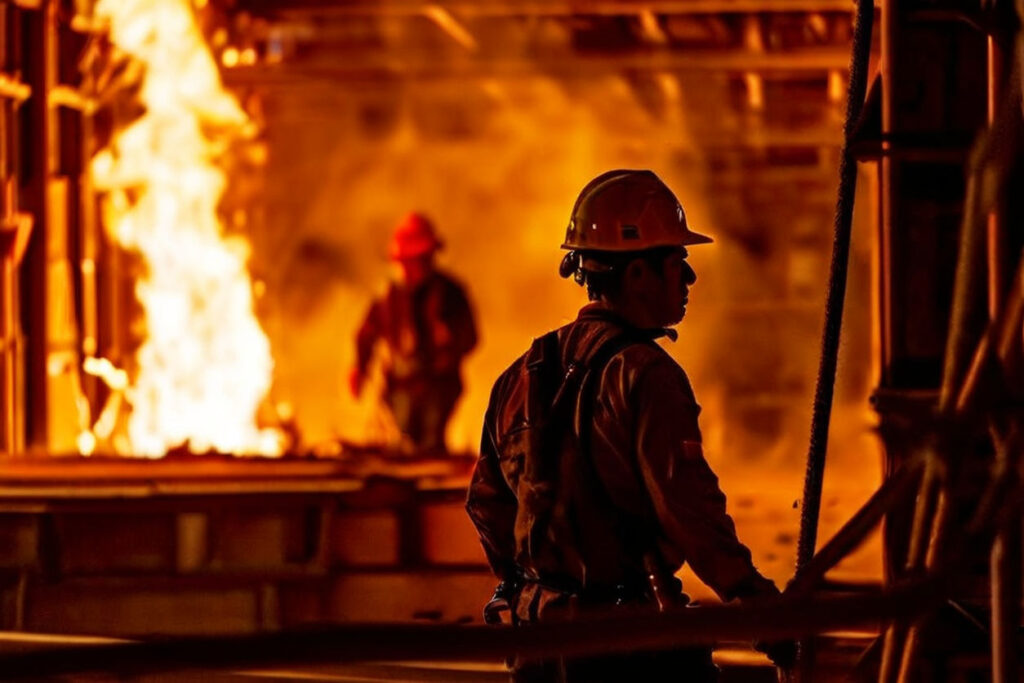Construction sites have become activity centers. They frequently store heavy machinery, flammable materials, and temporary electrical systems. These components, used together, increase the risk of fire. Ensure fire safety on building sites. It safeguards people, equipment, and the entire project timeframe.
This blog dives into efficient methods for preventing fires on construction sites. It focuses on the function of excavators and backhoe loaders in ensuring safety.
Addressing significant fire hazards
Materials Prone to Combustion
Building sites sometimes contain flammable items such as paper, timber, chemical compounds, and fuel. Proper storage and management of these goods are critical to reducing fire dangers.
It is critical to keep flammable materials in specified locations away from potential places of ignition.
Electrical Hazards
Building sites commonly use temporary power systems. Incorrect wiring, congested circuits, or the wrong usage of electrical equipment can cause electrical fires.
Ongoing examinations and upkeep of electrical structures can diligently avoid such hazards.
Heavy-Duty Equipment
Heavy machinery, such as excavators and backhoe loaders, may additionally trigger fires. Mechanical fluid leaks, overheated engines, and electrical faults in these machinery can all cause fires.
To reduce these risks, frequent maintenance of equipment and inspections is necessary.
Essential Tactics for Fire Prevention
Training and Awareness
Train workers on fire safety measures. This involves teaching kids how to handle dangerous products, follow emergency protocols, and use fire extinguishers.
Regular fire drills also ensure that everyone understands what to do in the event of a fire.
Machinery Operation
Operators of equipment, which includes excavators as well as backhoe loaders, should undertake specialist fire safety training.
They must be informed of the possible fire dangers associated with this equipment and ready to take action if a fire breaks out.
Correct storage and handling
Flammable Materials
Combustible goods should be stored in well-ventilated spaces away from ignition sources. Chemicals and other extremely explosive substances should be stored in fire-resistant cabinets.
Also, make sure all containers are correctly labelled and sealed.
Fuel Storage
Fuel should only be stored in certified containers and permitted places. Implement stringent refueling practices, including turning off and cooling engines before refilling.
Keep fuel storage places apart from other combustibles.
Electrical Safety
Inspection and Maintenance
Regularly check every electrical system for wear and tear. Replace any damaged wiring or equipment promptly.
Ensure that any temporary electrical installations meet safety requirements and are installed by trained individuals.
Overload Protection
To avoid electrical fires, employ electrical circuit breakers and overload safeguard devices. Avoid overloading circuits, and ensure proper grounding of all electrical equipment.
Fire Safety Equipment
Fire Extinguishers
Equip the building site with appropriate fire extinguishers that are conveniently accessible. Put fire extinguishers near possible fire threats, such as gasoline storage tanks, electrical equipment, and heavy machinery.
Fire Alarms and Detectors
Install smoke and fire sensors throughout the building site. Regularly test these gadgets to ensure they are working properly.
Early identification of fires may decrease damage and enhance the likelihood of a safe escape.
Emergency Exits
Ensuring that every staff member is aware of the emergency exits & evacuation paths. Exits ought to remain plainly visible and unimpeded in all situations.
Perform periodic evacuation drills to emphasize their necessity. These training exercises highlight the importance of a fast and efficient evacuation.
Important Prerequisites for Excavators and Backhoe Loaders
Timely upkeep
Do monthly checks of excavators & backhoe loader to detect and resolve any fire risks. Look for hydraulic fluid leaks, electrical issues, and indicators of overheating.
Regular inspections can keep minor concerns from becoming severe fire threats.
Cleaning
Keep equipment clean and debris-free. Accumulated dirt, oil, and other elements may catch fire and start fires. Always clean engine chambers and other high-risk locations.
Refueling Protocols
To avoid fires caused by gasoline, adhere to precise refueling practices. Before refilling, make sure to switch off the machinery and let it cool down.
Use adequate containers to prevent spillage.
Monitoring
Operators must continually check the operational state of their equipment while it is in use. Look for signs of overheating, unusual scents, or smoke and address them immediately.
Emergency Response Plan
Developing a Plan
Create a detailed emergency response plan, including firefighting protocols. The strategy should describe all personnel’s obligations and duties during an unforeseen situation.
It should also include communication methods and procedures for evacuation.
Training
Train all employees on the emergency response strategy. Conduct frequent exercises to ensure everyone is familiar with their tasks.
These exercises help individuals understand how to respond quickly and efficiently in the event of a fire.
Coordinating with Local Authorities
Fire Department Liaison
Set up a relationship with the fire department in your area. Share the building site plan and information about potential fire dangers with them.
This cooperation can speed up the reaction time and efficacy of firefighting actions.
Regular Updates
Keep local authorities aware of any modifications to the site that may influence fire safety, like the installation of new structures, materials, or machinery.
Regular upgrades guarantee that firefighters are ready to handle any circumstance.
Conclusion
Eliminating fire threats on construction sites necessitates a proactive strategy. This strategy should include training, correct storage, frequent maintenance, and the use of suitable safety equipment.
Building equipment must be utilized and maintained properly. Implementing appropriate procedures may minimize the danger of fire on building sites.



